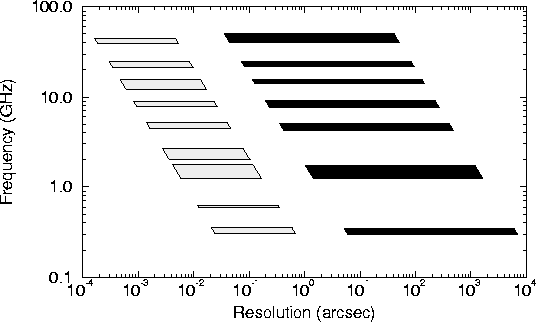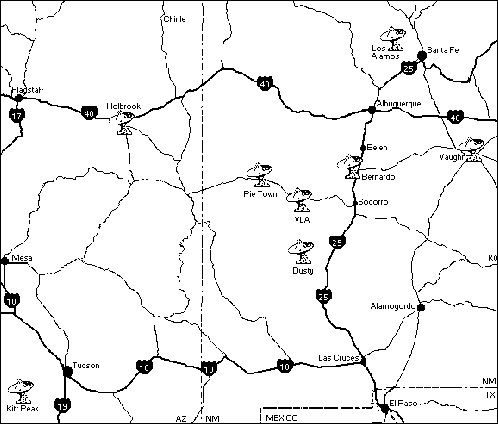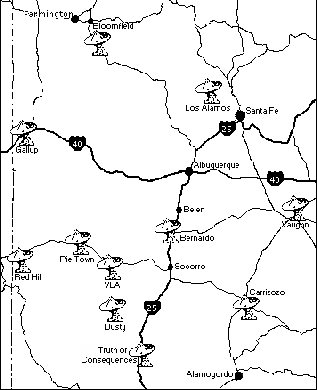



Next: Example imaging with the
Up: TECHNICAL OVERVIEW
Previous: Improved Surface-Brightness Sensitivity
There is a serious gap in coverage between the 35-km longest
baseline of the VLA and the 200-km shortest baseline of the VLBA. This
gap is well illustrated in the frequency-resolution plot shown in
Figure 2.6.

Figure: The frequency-resolution coverage of the VLA (dark) and
VLBA (shaded). The sloping ``VLA-VLBA Gap'' is caused
by the absence of antennas with separations between 35 and 250
km. Much astrophysical analysis depends on
imaging at fixed angular resolution over a wide frequency range,
on vertical lines in this diagram. The ``gap''
seriously restricts interpretative work at resolutions from a
few hundred milli-arcseconds to one arcsecond.

Figure: Possible antenna locations for a six-antenna A+ configuration,
as suggested in the (1995). Four new antennas are added, at
Dusty, Bernardo and Vaughn in New Mexico and at Holbrook, in Arizona.
The absence of imaging capability on scales between the VLA and VLBA
severely limits scientific investigation of a wide range of phenomena.
The gap extends over angular scales of tens to hundreds of
milli-arcseconds - a range critical for studies of stellar emission,
star-formation, radio jets, and gravitational lenses, to name just a
few.
Sub-arc-second resolution observations with the present VLA are
possible only at the higher frequencies where the brightness
sensitivity needed to detect nonthermal phenomena is usually
inadequate because of the source spectra. These frequencies may also
be inappropriate for projects in which Faraday depth effects,
wide-band spectral shapes, or low-frequency spectral lines are needed
to probe source physics at these resolutions. There are also many
instances where studies of normal stellar radio emission will benefit
greatly from increasing both the resolution and sensitivity of the VLA
together at higher frequencies.
The reconfigurability of the VLA (its capacity for ``scaled array''
observations with the same angular resolution at several frequencies)
has been vital to its astrophysical success. This distinctive
capability of the VLA is now present across the whole frequency
range from 330 MHz to 22 GHz only at resolutions between
 and
and  . No problem that requires higher angular
resolution than
. No problem that requires higher angular
resolution than  and full frequency coverage can now be
tackled in scaled-array mode. This situation improves dramatically -
by a factor of order ten - if we can add data from longer baselines
in an A+ configuration that includes the two innermost VLBA antennas.
and full frequency coverage can now be
tackled in scaled-array mode. This situation improves dramatically -
by a factor of order ten - if we can add data from longer baselines
in an A+ configuration that includes the two innermost VLBA antennas.
Finally, we note that the availability of optical imagery at  resolution from the Hubble Space Telescope is emphasizing the need for
better coverage of this resolution regime over a full range of radio
frequencies. This resolution falls squarely in the ``uncovered gap''
between the VLA and VLBA at just the frequencies where imaging would
be least corrupted by atmospheric and ionospheric phenomena. The NGST
may also provide complementary near infrared imaging at similar
resolutions.
resolution from the Hubble Space Telescope is emphasizing the need for
better coverage of this resolution regime over a full range of radio
frequencies. This resolution falls squarely in the ``uncovered gap''
between the VLA and VLBA at just the frequencies where imaging would
be least corrupted by atmospheric and ionospheric phenomena. The NGST
may also provide complementary near infrared imaging at similar
resolutions.
We therefore plan to bridge this gap by adding new antennas
distributed between 50 and about 400 km from the VLA, and by enabling
some VLA, some VLBA, and all of the new antennas to be used
interchangeably as members of either array.
These enhancements will (a) increase the resolution of the VLA at all
frequencies and enlarge the range of resolutions over which it
has ``scaled-array capability'', (b) improve the dynamic range, field
of view and low-surface-brightness sensitivity of the VLBA, and (c)
provide the VLBA with a ``scaled-array'' capability similar to the
VLA's, which it presently lacks.

Figure: Possible antenna locations for a ten-antenna A+ configuration.
Eight new antennas are added in this configuration, at Dusty and
Bernardo
for the inner ring, and at Vaughn, Carrizozo, Truth Or Consequences,
Red Hill, Gallup and Bloomfield for the outer ring. This arrangement
results in much better imaging performance than the six-antenna
arrangement shown in Fig. 2.7.
New antennas would therefore be built in New Mexico and Arizona to
improve the density of coverage in the 35-400 km baseline range.
All proposed distributions include completing the ``Pie Town ring''
around the VLA by adding two new antennas at distances of 50 to 80 km
to the south and north-east of the VLA at Dusty, NM and Bernardo, NM.
Adding only the existing Pie Town VLBA antenna to the VLA (as in the
demonstration project that the NRAO is undertaking with NSF Major
Research Instrumentation funding) doubles the resolution of the A
configuration, but only for northern sources. Adding the two new
antennas at approximately the same distance from the VLA as Pie Town
extends this capability to the whole sky.
A further step is to add new antennas in the ``Los Alamos ring''.
Several configuration options are being investigated to determine the
cost-effectiveness of using different numbers of antennas in this
outer ring. Figure 2.7 shows the minimal arrangement
that was proposed in the . This places one new antenna in the
outer ring near Vaughn, New Mexico and a second antenna in this ring
near Holbrook, Arizona. This configuration fills the major holes in
the plane at most declinations, but denser coverage of this
baseline range, the configuration with eight new antennas shown in
Figure 2.8 would be needed to retain VLA-like image
quality with the A+ configuration resolution in the presence of
realistic noise, as demonstrated with example imaging below. The
configuration shown in Figure
2.8 approximates a  300-km ring of
seven equally-spaced antennas (to give uniform
coverage), including the Los Alamos
VLBA antenna, and centered on a line between Los Alamos and the VLA.
The antenna locations have been adjusted from the uniform spacing
on the ring to allow access from nearby major roads.
300-km ring of
seven equally-spaced antennas (to give uniform
coverage), including the Los Alamos
VLBA antenna, and centered on a line between Los Alamos and the VLA.
The antenna locations have been adjusted from the uniform spacing
on the ring to allow access from nearby major roads.




Next: Example imaging with the
Up: TECHNICAL OVERVIEW
Previous: Improved Surface-Brightness Sensitivity
Michael Rupen
Fri Mar 26 15:30:00 MST 1999


